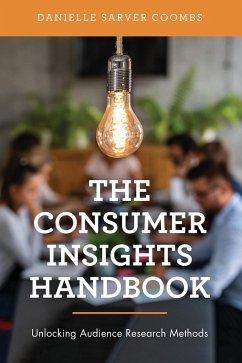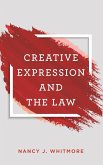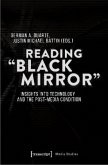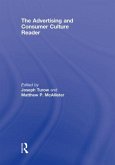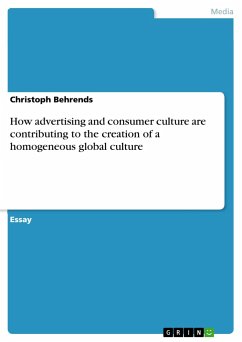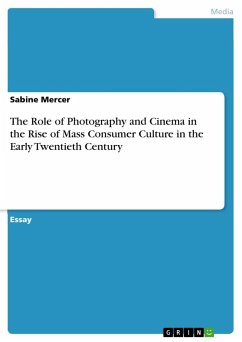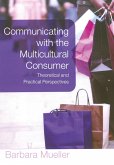- Gebundenes Buch
- Merkliste
- Auf die Merkliste
- Bewerten Bewerten
- Teilen
- Produkt teilen
- Produkterinnerung
- Produkterinnerung
This practical introduction to audience research shows students that conducting consumer research is not only a necessary skill for any future media professional but that it can also be a creative and fun experience. Students learn how to plan for and complete a research projects from the initial RFP to the final presentation of findings.
Andere Kunden interessierten sich auch für
![Creative Expression and the Law Creative Expression and the Law]() Nancy WhitmoreCreative Expression and the Law108,99 €
Nancy WhitmoreCreative Expression and the Law108,99 €![Reading 'Black Mirror' - Insights into Technology and the Post-Media Condition Reading 'Black Mirror' - Insights into Technology and the Post-Media Condition]() Reading »Black Mirror«Reading 'Black Mirror' - Insights into Technology and the Post-Media Condition27,99 €
Reading »Black Mirror«Reading 'Black Mirror' - Insights into Technology and the Post-Media Condition27,99 €![Interdisciplinary Insights on Interpersonal Relationships Interdisciplinary Insights on Interpersonal Relationships]() Interdisciplinary Insights on Interpersonal Relationships105,99 €
Interdisciplinary Insights on Interpersonal Relationships105,99 €![The Advertising and Consumer Culture Reader The Advertising and Consumer Culture Reader]() The Advertising and Consumer Culture Reader187,99 €
The Advertising and Consumer Culture Reader187,99 €![How advertising and consumer culture are contributing to the creation of a homogeneous global culture How advertising and consumer culture are contributing to the creation of a homogeneous global culture]() Christoph BehrendsHow advertising and consumer culture are contributing to the creation of a homogeneous global culture15,95 €
Christoph BehrendsHow advertising and consumer culture are contributing to the creation of a homogeneous global culture15,95 €![The Role of Photography and Cinema in the Rise of Mass Consumer Culture in the Early Twentieth Century The Role of Photography and Cinema in the Rise of Mass Consumer Culture in the Early Twentieth Century]() Sabine MercerThe Role of Photography and Cinema in the Rise of Mass Consumer Culture in the Early Twentieth Century17,95 €
Sabine MercerThe Role of Photography and Cinema in the Rise of Mass Consumer Culture in the Early Twentieth Century17,95 €![Communicating with the Multicultural Consumer Communicating with the Multicultural Consumer]() Barbara MuellerCommunicating with the Multicultural Consumer136,05 €
Barbara MuellerCommunicating with the Multicultural Consumer136,05 €-
-
-
This practical introduction to audience research shows students that conducting consumer research is not only a necessary skill for any future media professional but that it can also be a creative and fun experience. Students learn how to plan for and complete a research projects from the initial RFP to the final presentation of findings.
Hinweis: Dieser Artikel kann nur an eine deutsche Lieferadresse ausgeliefert werden.
Hinweis: Dieser Artikel kann nur an eine deutsche Lieferadresse ausgeliefert werden.
Produktdetails
- Produktdetails
- Verlag: Rowman & Littlefield Publishers
- Seitenzahl: 248
- Erscheinungstermin: 22. Juni 2021
- Englisch
- Abmessung: 260mm x 183mm x 18mm
- Gewicht: 669g
- ISBN-13: 9781538145517
- ISBN-10: 1538145510
- Artikelnr.: 60004209
- Herstellerkennzeichnung
- Libri GmbH
- Europaallee 1
- 36244 Bad Hersfeld
- gpsr@libri.de
- Verlag: Rowman & Littlefield Publishers
- Seitenzahl: 248
- Erscheinungstermin: 22. Juni 2021
- Englisch
- Abmessung: 260mm x 183mm x 18mm
- Gewicht: 669g
- ISBN-13: 9781538145517
- ISBN-10: 1538145510
- Artikelnr.: 60004209
- Herstellerkennzeichnung
- Libri GmbH
- Europaallee 1
- 36244 Bad Hersfeld
- gpsr@libri.de
Danielle Sarver Coombs (Ph.D., Louisiana State University) is a professor in the School of Journalism and Mass Communication at Kent State University (Ohio, USA). She is the co-author of Female Fans of the NFL (Routledge, 2016) and author of Last Man Standing: Media, Framing, and the 2012 Republican Primary (Rowman & Littlefield, 2014). Coombs co-edited three anthologies for Praeger: Debates for the Digital Age (2015); We Are What We Sell (2014), and American History through American Sports (2012). Danielle has published research on sport fans and fandom in a number of prestigious journals, including the Howard Journal of Communications, Liminalities, the Journal of Sport & Social Issues, Sport in Society, International Journal of Sport Communication, and Public Relations Research. She served as the interim associate dean for the College of Communication and Information at Kent State University from 2016-2018. Before transitioning to academia, Danielle worked in consumer insights research for brands across a wide range of sectors, including fashion, media, public organizations, and consumer packaged goods.
Revised to Reflect the Reviewer Feedback
Part I: Preparation
Chapter 1: Introduction and Semester Overview
This chapter orients students to the world of consumer insights research,
offering important context to why this is important to learn, why this
textbook was written, and connecting both of these to the field of applied
consumer insights research. This will include basic information on how the
ways we see the world influences our approaches to research, as well as
more context for how multi-phase research is done in the field.
Because students often do not realize how robust the field is for consumer
insights researchers, this chapter also will highlight the career paths
available. Within this structure, readers will learn about how teams work
and learn some best practices for organizing and working with teams, based
on specific feedback and suggestions from practitioners. This chapter will
also address how media and strategic communication practitioners engage
with research in their own positions, even if they are not specialized in
the field. Finally, the differences between in-house, agency, and research
boutiques-including titles, responsibilities, and reporting chains-are
examined.
The chapter will conclude with an overview of how the book is structured
and how to best maximize value over the course of the semester. This is
designed to help students draw connections to and plan for their own
semester-long experiences, including tips on finding a client, managing
expectations, recruiting and conducting research, final presentations, etc.
Chapter 2: Working with your Client
This chapter focuses on all of the pieces that go into ensuring your client
(whether an external partner or internal team) and you are on the same
page. This will include responding to requests for proposals (RFPs),
helping understand and assess needs, establishing and working with budgets,
understanding business objectives and research objectives (and how they are
linked), and developing actionable research questions.
Chapter 3: Secondary Analysis
Projects often should start with a secondary analysis of available
information, whether from public or private sources. In this chapters,
students will learn about a range of tools that they can access (U.S.
Census, publicly available datasets) as well as strategies for conducting
assessments of media coverage and in-house materials.
Chapter 4: Ethics
Perhaps the most important chapter in the entire book, this chapter
explores the ethics of human subject research. Examples of past failures
will be explored and best practices will be introduced and explained,
including brief discussions of new and emerging privacy laws and
controversies over collection and use of data from vulnerable populations
(such as children). As is the case throughout the book, this will have an
explicitly applied focus, looking at situations that might come up when
conducting consumer insights research and encouraging students to think
through how to deal with them.
Part II: Qualitative Research
Chapter 5: Research Design and Considerations
In this chapter, students are introduced to the various methods of data
collection in qualitative research, both face-to-face (primarily
interviews, ethnographies, participant observation, and focus groups) and
online (online communities, digital ethnographies, etc.). The strengths and
weaknesses of each method are examined as well as advice on how to design
the best possible research project while balancing your objectives with
available resources (time and money). Finally, we will discuss how you
ensure rigor in qualitative research.
Chapter 6: Qualitative Data Collection
While students are exposed to qualitative methods in the previous chapter,
this chapter on data collection is focused on how you do these. How do you
write an effective instrument? How do you prepare? What techniques can you
employ to ensure you are getting good, quality data? What sorts of
innovations are happening in the field? How do you adapt and iterate, based
on your target audience? We also will revisit ethics, specifically in the
context of qualitative research.
Chapter 7: Using Creative Techniques for Deeper Insights
Because creative techniques (projectives, card sorts, ideation, mapping,
etc.) play such an important role in qualitative research, this chapter
will give specific information on what they are, how and when to implement
them, how to "sell" them to participants, the role they play in both data
collection and analysis, and strategies for using findings specifically
grounded in creative techniques during your client presentation.
Chapter 8: Qualitative Data Analysis
Coming out of the creative techniques chapter, this chapter will cover the
various strategies for qualitative data analysis, including the importance
of debriefing and the roles each team member can-and should-play in the
process. This chapter also is intended to help students transition from
their roles as students to researchers, particularly in terms of finding
the story grounded in the data versus their own personal experiences.
Chapter 9: Reporting Findings
This final chapter in the qualitative section of the book offers basic best
practices on how to present qualitative data to your team and/or clients,
including a wide range of written and multimedia formats. This also will
give advice on how to draw insight from the qualitative findings to
transition to a quantitative phase of research in a multi-method and/or
multi-phase project.
Part III: Quantitative Research
Chapter 10: Research Design and Considerations
As was the case in the qualitative section above, this chapter is intended
to ground students in common quantitative research practices. This
primarily will focus on survey research, including an overview of
probability versus non-probability samples, recruitment strategies, and
basic considerations when determining sizes for samples and subsamples.
This chapter will include a separate section providing an introduction to
quantitative concepts and terms, intended to provide a basic foundation. We
will reiterate that students will not learn to do sophisticated
quantitative analysis through this textbook, and provide suggestions for
online courses and commonly used university course title for those
interested in pursuing that field of study.
Chapter 11: Quantitative Data Collection
The emphasis on survey research will continue in this chapter, including
specific recommendations and guidelines for writing quality survey
questions that address your client's objectives and research questions.
This will include extensive examples of question and response types and
strategies for ensuring you generate the best possible data through your
instruments.
Chapter 12: Quantitative Data Analysis
The consumer insight roles that most communication-based undergraduate
students would take on do not require advanced knowledge of statistical
testing. In this chapter, we will focus on the types of data analysis
consumer insight researchers would more typically do (usually in
collaboration with a statistician), including information on which tests to
run, how to look at correlations, and how to derive meaning to tell the
data-based story to your client. This will also include cluster analyses
and typing tools, a commonly used approach to audience segmentation, as
well as quick overviews of the purpose behind other statistical approaches
(factor analysis, conjoint, etc.).
Chapter 13: Reporting Findings
As was the case in the qualitative section, this chapter offers best
practices on presenting quantitative research findings to your client. This
will include specific instructions and recommendations for data
visualization and how to present data effectively. Finally, we will offer
recommendations for how to use quantitative findings as the foundation for
a qualitative "phase two" in a multi-method research project.
Part IV: Reporting Findings
Chapter 14: Writing your Report
While proposed Chapters 11 and 15 focus on the individual pieces, this
section brings the methods together in the context of a full-scale research
report that includes all findings from multi-phase research projects. This
chapter focuses on written, document-based reports, including executive
summaries and full-scale reports. This also will include a section on
recommendations.
Chapter 15: Developing your Visual Presentation
Decks are the backbone of consumer insights research. This chapter outlines
what should be included, makes recommendations for structure, and helps
students start to think about how they can effectively tell their research
story to the client through a combination of evidence and insight.
Furthermore, emerging modes of presentation-dashboards, newsletters,
infographics, etc.-are introduced along with suggestions for how to fit
your visuals and presentation to your client's wants and needs.
Chapter 16: Great Research, Great Design
While other chapters touch on design, this chapter foregrounds the
importance of good design in both written documents and visually oriented
materials. This will include examples of both good and bad work as well as
specific recommendations from those working in the field. Finally, an
overview of basic tools will be given to help students develop their own
work.
Chapter 17: The Client Presentation
Consumer insights researchers often find themselves presenting their work
to a room full of clients and executives. This chapter gives
recommendations for students as they prepare for and conduct in-person
presentations, including strategies for internalizing (rather than
memorizing), sharing information, and answering questions.
Chapter 18: Parting Thoughts
In this final (short) chapter, advice from current consumer insights
professionals and final recommendations and reminders will provide a
useful, upbeat conclusion to the textbook.
Part I: Preparation
Chapter 1: Introduction and Semester Overview
This chapter orients students to the world of consumer insights research,
offering important context to why this is important to learn, why this
textbook was written, and connecting both of these to the field of applied
consumer insights research. This will include basic information on how the
ways we see the world influences our approaches to research, as well as
more context for how multi-phase research is done in the field.
Because students often do not realize how robust the field is for consumer
insights researchers, this chapter also will highlight the career paths
available. Within this structure, readers will learn about how teams work
and learn some best practices for organizing and working with teams, based
on specific feedback and suggestions from practitioners. This chapter will
also address how media and strategic communication practitioners engage
with research in their own positions, even if they are not specialized in
the field. Finally, the differences between in-house, agency, and research
boutiques-including titles, responsibilities, and reporting chains-are
examined.
The chapter will conclude with an overview of how the book is structured
and how to best maximize value over the course of the semester. This is
designed to help students draw connections to and plan for their own
semester-long experiences, including tips on finding a client, managing
expectations, recruiting and conducting research, final presentations, etc.
Chapter 2: Working with your Client
This chapter focuses on all of the pieces that go into ensuring your client
(whether an external partner or internal team) and you are on the same
page. This will include responding to requests for proposals (RFPs),
helping understand and assess needs, establishing and working with budgets,
understanding business objectives and research objectives (and how they are
linked), and developing actionable research questions.
Chapter 3: Secondary Analysis
Projects often should start with a secondary analysis of available
information, whether from public or private sources. In this chapters,
students will learn about a range of tools that they can access (U.S.
Census, publicly available datasets) as well as strategies for conducting
assessments of media coverage and in-house materials.
Chapter 4: Ethics
Perhaps the most important chapter in the entire book, this chapter
explores the ethics of human subject research. Examples of past failures
will be explored and best practices will be introduced and explained,
including brief discussions of new and emerging privacy laws and
controversies over collection and use of data from vulnerable populations
(such as children). As is the case throughout the book, this will have an
explicitly applied focus, looking at situations that might come up when
conducting consumer insights research and encouraging students to think
through how to deal with them.
Part II: Qualitative Research
Chapter 5: Research Design and Considerations
In this chapter, students are introduced to the various methods of data
collection in qualitative research, both face-to-face (primarily
interviews, ethnographies, participant observation, and focus groups) and
online (online communities, digital ethnographies, etc.). The strengths and
weaknesses of each method are examined as well as advice on how to design
the best possible research project while balancing your objectives with
available resources (time and money). Finally, we will discuss how you
ensure rigor in qualitative research.
Chapter 6: Qualitative Data Collection
While students are exposed to qualitative methods in the previous chapter,
this chapter on data collection is focused on how you do these. How do you
write an effective instrument? How do you prepare? What techniques can you
employ to ensure you are getting good, quality data? What sorts of
innovations are happening in the field? How do you adapt and iterate, based
on your target audience? We also will revisit ethics, specifically in the
context of qualitative research.
Chapter 7: Using Creative Techniques for Deeper Insights
Because creative techniques (projectives, card sorts, ideation, mapping,
etc.) play such an important role in qualitative research, this chapter
will give specific information on what they are, how and when to implement
them, how to "sell" them to participants, the role they play in both data
collection and analysis, and strategies for using findings specifically
grounded in creative techniques during your client presentation.
Chapter 8: Qualitative Data Analysis
Coming out of the creative techniques chapter, this chapter will cover the
various strategies for qualitative data analysis, including the importance
of debriefing and the roles each team member can-and should-play in the
process. This chapter also is intended to help students transition from
their roles as students to researchers, particularly in terms of finding
the story grounded in the data versus their own personal experiences.
Chapter 9: Reporting Findings
This final chapter in the qualitative section of the book offers basic best
practices on how to present qualitative data to your team and/or clients,
including a wide range of written and multimedia formats. This also will
give advice on how to draw insight from the qualitative findings to
transition to a quantitative phase of research in a multi-method and/or
multi-phase project.
Part III: Quantitative Research
Chapter 10: Research Design and Considerations
As was the case in the qualitative section above, this chapter is intended
to ground students in common quantitative research practices. This
primarily will focus on survey research, including an overview of
probability versus non-probability samples, recruitment strategies, and
basic considerations when determining sizes for samples and subsamples.
This chapter will include a separate section providing an introduction to
quantitative concepts and terms, intended to provide a basic foundation. We
will reiterate that students will not learn to do sophisticated
quantitative analysis through this textbook, and provide suggestions for
online courses and commonly used university course title for those
interested in pursuing that field of study.
Chapter 11: Quantitative Data Collection
The emphasis on survey research will continue in this chapter, including
specific recommendations and guidelines for writing quality survey
questions that address your client's objectives and research questions.
This will include extensive examples of question and response types and
strategies for ensuring you generate the best possible data through your
instruments.
Chapter 12: Quantitative Data Analysis
The consumer insight roles that most communication-based undergraduate
students would take on do not require advanced knowledge of statistical
testing. In this chapter, we will focus on the types of data analysis
consumer insight researchers would more typically do (usually in
collaboration with a statistician), including information on which tests to
run, how to look at correlations, and how to derive meaning to tell the
data-based story to your client. This will also include cluster analyses
and typing tools, a commonly used approach to audience segmentation, as
well as quick overviews of the purpose behind other statistical approaches
(factor analysis, conjoint, etc.).
Chapter 13: Reporting Findings
As was the case in the qualitative section, this chapter offers best
practices on presenting quantitative research findings to your client. This
will include specific instructions and recommendations for data
visualization and how to present data effectively. Finally, we will offer
recommendations for how to use quantitative findings as the foundation for
a qualitative "phase two" in a multi-method research project.
Part IV: Reporting Findings
Chapter 14: Writing your Report
While proposed Chapters 11 and 15 focus on the individual pieces, this
section brings the methods together in the context of a full-scale research
report that includes all findings from multi-phase research projects. This
chapter focuses on written, document-based reports, including executive
summaries and full-scale reports. This also will include a section on
recommendations.
Chapter 15: Developing your Visual Presentation
Decks are the backbone of consumer insights research. This chapter outlines
what should be included, makes recommendations for structure, and helps
students start to think about how they can effectively tell their research
story to the client through a combination of evidence and insight.
Furthermore, emerging modes of presentation-dashboards, newsletters,
infographics, etc.-are introduced along with suggestions for how to fit
your visuals and presentation to your client's wants and needs.
Chapter 16: Great Research, Great Design
While other chapters touch on design, this chapter foregrounds the
importance of good design in both written documents and visually oriented
materials. This will include examples of both good and bad work as well as
specific recommendations from those working in the field. Finally, an
overview of basic tools will be given to help students develop their own
work.
Chapter 17: The Client Presentation
Consumer insights researchers often find themselves presenting their work
to a room full of clients and executives. This chapter gives
recommendations for students as they prepare for and conduct in-person
presentations, including strategies for internalizing (rather than
memorizing), sharing information, and answering questions.
Chapter 18: Parting Thoughts
In this final (short) chapter, advice from current consumer insights
professionals and final recommendations and reminders will provide a
useful, upbeat conclusion to the textbook.
Revised to Reflect the Reviewer Feedback
Part I: Preparation
Chapter 1: Introduction and Semester Overview
This chapter orients students to the world of consumer insights research,
offering important context to why this is important to learn, why this
textbook was written, and connecting both of these to the field of applied
consumer insights research. This will include basic information on how the
ways we see the world influences our approaches to research, as well as
more context for how multi-phase research is done in the field.
Because students often do not realize how robust the field is for consumer
insights researchers, this chapter also will highlight the career paths
available. Within this structure, readers will learn about how teams work
and learn some best practices for organizing and working with teams, based
on specific feedback and suggestions from practitioners. This chapter will
also address how media and strategic communication practitioners engage
with research in their own positions, even if they are not specialized in
the field. Finally, the differences between in-house, agency, and research
boutiques-including titles, responsibilities, and reporting chains-are
examined.
The chapter will conclude with an overview of how the book is structured
and how to best maximize value over the course of the semester. This is
designed to help students draw connections to and plan for their own
semester-long experiences, including tips on finding a client, managing
expectations, recruiting and conducting research, final presentations, etc.
Chapter 2: Working with your Client
This chapter focuses on all of the pieces that go into ensuring your client
(whether an external partner or internal team) and you are on the same
page. This will include responding to requests for proposals (RFPs),
helping understand and assess needs, establishing and working with budgets,
understanding business objectives and research objectives (and how they are
linked), and developing actionable research questions.
Chapter 3: Secondary Analysis
Projects often should start with a secondary analysis of available
information, whether from public or private sources. In this chapters,
students will learn about a range of tools that they can access (U.S.
Census, publicly available datasets) as well as strategies for conducting
assessments of media coverage and in-house materials.
Chapter 4: Ethics
Perhaps the most important chapter in the entire book, this chapter
explores the ethics of human subject research. Examples of past failures
will be explored and best practices will be introduced and explained,
including brief discussions of new and emerging privacy laws and
controversies over collection and use of data from vulnerable populations
(such as children). As is the case throughout the book, this will have an
explicitly applied focus, looking at situations that might come up when
conducting consumer insights research and encouraging students to think
through how to deal with them.
Part II: Qualitative Research
Chapter 5: Research Design and Considerations
In this chapter, students are introduced to the various methods of data
collection in qualitative research, both face-to-face (primarily
interviews, ethnographies, participant observation, and focus groups) and
online (online communities, digital ethnographies, etc.). The strengths and
weaknesses of each method are examined as well as advice on how to design
the best possible research project while balancing your objectives with
available resources (time and money). Finally, we will discuss how you
ensure rigor in qualitative research.
Chapter 6: Qualitative Data Collection
While students are exposed to qualitative methods in the previous chapter,
this chapter on data collection is focused on how you do these. How do you
write an effective instrument? How do you prepare? What techniques can you
employ to ensure you are getting good, quality data? What sorts of
innovations are happening in the field? How do you adapt and iterate, based
on your target audience? We also will revisit ethics, specifically in the
context of qualitative research.
Chapter 7: Using Creative Techniques for Deeper Insights
Because creative techniques (projectives, card sorts, ideation, mapping,
etc.) play such an important role in qualitative research, this chapter
will give specific information on what they are, how and when to implement
them, how to "sell" them to participants, the role they play in both data
collection and analysis, and strategies for using findings specifically
grounded in creative techniques during your client presentation.
Chapter 8: Qualitative Data Analysis
Coming out of the creative techniques chapter, this chapter will cover the
various strategies for qualitative data analysis, including the importance
of debriefing and the roles each team member can-and should-play in the
process. This chapter also is intended to help students transition from
their roles as students to researchers, particularly in terms of finding
the story grounded in the data versus their own personal experiences.
Chapter 9: Reporting Findings
This final chapter in the qualitative section of the book offers basic best
practices on how to present qualitative data to your team and/or clients,
including a wide range of written and multimedia formats. This also will
give advice on how to draw insight from the qualitative findings to
transition to a quantitative phase of research in a multi-method and/or
multi-phase project.
Part III: Quantitative Research
Chapter 10: Research Design and Considerations
As was the case in the qualitative section above, this chapter is intended
to ground students in common quantitative research practices. This
primarily will focus on survey research, including an overview of
probability versus non-probability samples, recruitment strategies, and
basic considerations when determining sizes for samples and subsamples.
This chapter will include a separate section providing an introduction to
quantitative concepts and terms, intended to provide a basic foundation. We
will reiterate that students will not learn to do sophisticated
quantitative analysis through this textbook, and provide suggestions for
online courses and commonly used university course title for those
interested in pursuing that field of study.
Chapter 11: Quantitative Data Collection
The emphasis on survey research will continue in this chapter, including
specific recommendations and guidelines for writing quality survey
questions that address your client's objectives and research questions.
This will include extensive examples of question and response types and
strategies for ensuring you generate the best possible data through your
instruments.
Chapter 12: Quantitative Data Analysis
The consumer insight roles that most communication-based undergraduate
students would take on do not require advanced knowledge of statistical
testing. In this chapter, we will focus on the types of data analysis
consumer insight researchers would more typically do (usually in
collaboration with a statistician), including information on which tests to
run, how to look at correlations, and how to derive meaning to tell the
data-based story to your client. This will also include cluster analyses
and typing tools, a commonly used approach to audience segmentation, as
well as quick overviews of the purpose behind other statistical approaches
(factor analysis, conjoint, etc.).
Chapter 13: Reporting Findings
As was the case in the qualitative section, this chapter offers best
practices on presenting quantitative research findings to your client. This
will include specific instructions and recommendations for data
visualization and how to present data effectively. Finally, we will offer
recommendations for how to use quantitative findings as the foundation for
a qualitative "phase two" in a multi-method research project.
Part IV: Reporting Findings
Chapter 14: Writing your Report
While proposed Chapters 11 and 15 focus on the individual pieces, this
section brings the methods together in the context of a full-scale research
report that includes all findings from multi-phase research projects. This
chapter focuses on written, document-based reports, including executive
summaries and full-scale reports. This also will include a section on
recommendations.
Chapter 15: Developing your Visual Presentation
Decks are the backbone of consumer insights research. This chapter outlines
what should be included, makes recommendations for structure, and helps
students start to think about how they can effectively tell their research
story to the client through a combination of evidence and insight.
Furthermore, emerging modes of presentation-dashboards, newsletters,
infographics, etc.-are introduced along with suggestions for how to fit
your visuals and presentation to your client's wants and needs.
Chapter 16: Great Research, Great Design
While other chapters touch on design, this chapter foregrounds the
importance of good design in both written documents and visually oriented
materials. This will include examples of both good and bad work as well as
specific recommendations from those working in the field. Finally, an
overview of basic tools will be given to help students develop their own
work.
Chapter 17: The Client Presentation
Consumer insights researchers often find themselves presenting their work
to a room full of clients and executives. This chapter gives
recommendations for students as they prepare for and conduct in-person
presentations, including strategies for internalizing (rather than
memorizing), sharing information, and answering questions.
Chapter 18: Parting Thoughts
In this final (short) chapter, advice from current consumer insights
professionals and final recommendations and reminders will provide a
useful, upbeat conclusion to the textbook.
Part I: Preparation
Chapter 1: Introduction and Semester Overview
This chapter orients students to the world of consumer insights research,
offering important context to why this is important to learn, why this
textbook was written, and connecting both of these to the field of applied
consumer insights research. This will include basic information on how the
ways we see the world influences our approaches to research, as well as
more context for how multi-phase research is done in the field.
Because students often do not realize how robust the field is for consumer
insights researchers, this chapter also will highlight the career paths
available. Within this structure, readers will learn about how teams work
and learn some best practices for organizing and working with teams, based
on specific feedback and suggestions from practitioners. This chapter will
also address how media and strategic communication practitioners engage
with research in their own positions, even if they are not specialized in
the field. Finally, the differences between in-house, agency, and research
boutiques-including titles, responsibilities, and reporting chains-are
examined.
The chapter will conclude with an overview of how the book is structured
and how to best maximize value over the course of the semester. This is
designed to help students draw connections to and plan for their own
semester-long experiences, including tips on finding a client, managing
expectations, recruiting and conducting research, final presentations, etc.
Chapter 2: Working with your Client
This chapter focuses on all of the pieces that go into ensuring your client
(whether an external partner or internal team) and you are on the same
page. This will include responding to requests for proposals (RFPs),
helping understand and assess needs, establishing and working with budgets,
understanding business objectives and research objectives (and how they are
linked), and developing actionable research questions.
Chapter 3: Secondary Analysis
Projects often should start with a secondary analysis of available
information, whether from public or private sources. In this chapters,
students will learn about a range of tools that they can access (U.S.
Census, publicly available datasets) as well as strategies for conducting
assessments of media coverage and in-house materials.
Chapter 4: Ethics
Perhaps the most important chapter in the entire book, this chapter
explores the ethics of human subject research. Examples of past failures
will be explored and best practices will be introduced and explained,
including brief discussions of new and emerging privacy laws and
controversies over collection and use of data from vulnerable populations
(such as children). As is the case throughout the book, this will have an
explicitly applied focus, looking at situations that might come up when
conducting consumer insights research and encouraging students to think
through how to deal with them.
Part II: Qualitative Research
Chapter 5: Research Design and Considerations
In this chapter, students are introduced to the various methods of data
collection in qualitative research, both face-to-face (primarily
interviews, ethnographies, participant observation, and focus groups) and
online (online communities, digital ethnographies, etc.). The strengths and
weaknesses of each method are examined as well as advice on how to design
the best possible research project while balancing your objectives with
available resources (time and money). Finally, we will discuss how you
ensure rigor in qualitative research.
Chapter 6: Qualitative Data Collection
While students are exposed to qualitative methods in the previous chapter,
this chapter on data collection is focused on how you do these. How do you
write an effective instrument? How do you prepare? What techniques can you
employ to ensure you are getting good, quality data? What sorts of
innovations are happening in the field? How do you adapt and iterate, based
on your target audience? We also will revisit ethics, specifically in the
context of qualitative research.
Chapter 7: Using Creative Techniques for Deeper Insights
Because creative techniques (projectives, card sorts, ideation, mapping,
etc.) play such an important role in qualitative research, this chapter
will give specific information on what they are, how and when to implement
them, how to "sell" them to participants, the role they play in both data
collection and analysis, and strategies for using findings specifically
grounded in creative techniques during your client presentation.
Chapter 8: Qualitative Data Analysis
Coming out of the creative techniques chapter, this chapter will cover the
various strategies for qualitative data analysis, including the importance
of debriefing and the roles each team member can-and should-play in the
process. This chapter also is intended to help students transition from
their roles as students to researchers, particularly in terms of finding
the story grounded in the data versus their own personal experiences.
Chapter 9: Reporting Findings
This final chapter in the qualitative section of the book offers basic best
practices on how to present qualitative data to your team and/or clients,
including a wide range of written and multimedia formats. This also will
give advice on how to draw insight from the qualitative findings to
transition to a quantitative phase of research in a multi-method and/or
multi-phase project.
Part III: Quantitative Research
Chapter 10: Research Design and Considerations
As was the case in the qualitative section above, this chapter is intended
to ground students in common quantitative research practices. This
primarily will focus on survey research, including an overview of
probability versus non-probability samples, recruitment strategies, and
basic considerations when determining sizes for samples and subsamples.
This chapter will include a separate section providing an introduction to
quantitative concepts and terms, intended to provide a basic foundation. We
will reiterate that students will not learn to do sophisticated
quantitative analysis through this textbook, and provide suggestions for
online courses and commonly used university course title for those
interested in pursuing that field of study.
Chapter 11: Quantitative Data Collection
The emphasis on survey research will continue in this chapter, including
specific recommendations and guidelines for writing quality survey
questions that address your client's objectives and research questions.
This will include extensive examples of question and response types and
strategies for ensuring you generate the best possible data through your
instruments.
Chapter 12: Quantitative Data Analysis
The consumer insight roles that most communication-based undergraduate
students would take on do not require advanced knowledge of statistical
testing. In this chapter, we will focus on the types of data analysis
consumer insight researchers would more typically do (usually in
collaboration with a statistician), including information on which tests to
run, how to look at correlations, and how to derive meaning to tell the
data-based story to your client. This will also include cluster analyses
and typing tools, a commonly used approach to audience segmentation, as
well as quick overviews of the purpose behind other statistical approaches
(factor analysis, conjoint, etc.).
Chapter 13: Reporting Findings
As was the case in the qualitative section, this chapter offers best
practices on presenting quantitative research findings to your client. This
will include specific instructions and recommendations for data
visualization and how to present data effectively. Finally, we will offer
recommendations for how to use quantitative findings as the foundation for
a qualitative "phase two" in a multi-method research project.
Part IV: Reporting Findings
Chapter 14: Writing your Report
While proposed Chapters 11 and 15 focus on the individual pieces, this
section brings the methods together in the context of a full-scale research
report that includes all findings from multi-phase research projects. This
chapter focuses on written, document-based reports, including executive
summaries and full-scale reports. This also will include a section on
recommendations.
Chapter 15: Developing your Visual Presentation
Decks are the backbone of consumer insights research. This chapter outlines
what should be included, makes recommendations for structure, and helps
students start to think about how they can effectively tell their research
story to the client through a combination of evidence and insight.
Furthermore, emerging modes of presentation-dashboards, newsletters,
infographics, etc.-are introduced along with suggestions for how to fit
your visuals and presentation to your client's wants and needs.
Chapter 16: Great Research, Great Design
While other chapters touch on design, this chapter foregrounds the
importance of good design in both written documents and visually oriented
materials. This will include examples of both good and bad work as well as
specific recommendations from those working in the field. Finally, an
overview of basic tools will be given to help students develop their own
work.
Chapter 17: The Client Presentation
Consumer insights researchers often find themselves presenting their work
to a room full of clients and executives. This chapter gives
recommendations for students as they prepare for and conduct in-person
presentations, including strategies for internalizing (rather than
memorizing), sharing information, and answering questions.
Chapter 18: Parting Thoughts
In this final (short) chapter, advice from current consumer insights
professionals and final recommendations and reminders will provide a
useful, upbeat conclusion to the textbook.

